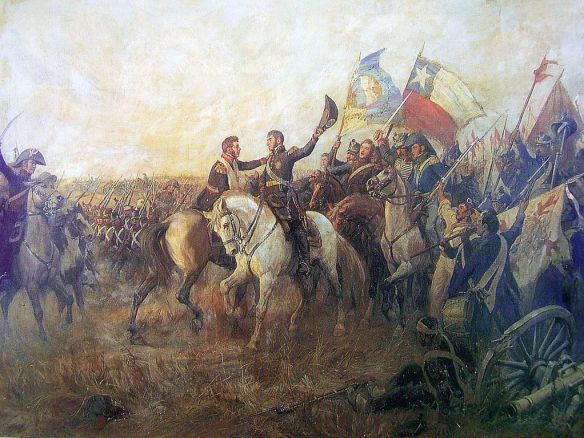Bernardo O’Higgins, supreme director of the patriot forces, salutes San Martín after victory in the Battle of Maipú.
By the time Napoleon Bonaparte betrayed Spain, his erstwhile ally, in 1808, deposing the king and replacing him with Bonaparte’s brother, discontent had already taken a firm hold in South America. Yet it was not until Napoleon conquered Spain that the colonies truly began to rise up. Juntas—military groups-cum-political rulers—took over Caracas and Quito in New Granada, Santiago in Peru, and Buenos Aires in Rio de la Plata: in all three Spanish viceroyalties, in other words. Spanish troops quickly defeated the juntas in the first three cities, but Buenos Aires proved stubbornly resistant. At first, the juntas proclaimed their loyalty to the deposed King Ferdinand, but Spain, acting on the authority of the Cortes regency, operating out of unconquered Cádiz, took umbrage at the predominantly Creole-dominated juntas and, in 1814, began sending forces to combat them.
The Royalists’ Return
Meanwhile, revolutionaries and royalists brought civil war to nearly every region of Spanish South America. The Buenos Aires junta tried three times to subdue the surrounding lands, the Viceroyalty of Rio de la Plata, without success. Upper Peru (Bolivia) proved especially intractable. Paraguay also repulsed Buenos Aires forces, but equally refused Spain, declaring independence from both in 1811. Uruguay, led by José Gervasio Artigas, broke away from Buenos Aires in 1815, leading a coalition called the Artigas Confederation against their former capital. Spain, marginally recovered from the Napoleonic disaster, sent an increasing number of troops to reestablish its faltering control in South America. The Viceroyalty of Peru, with its capital at Lima, initially offered safe haven; from there, troops reconquered their former territory, with the exceptions of Buenos Aires and pieces of Rio de la Plata. Their control was far from secure, however, and in the south, they were about to face one of their worst revolutionary foes: José de San Martín (1778–1850).
Across the Andes
San Martín, formerly a Spanish professional soldier, rose quickly in the ranks to become a general of the Buenos Aires army. He considered the independence of his city at risk until the royalist Spaniards were dislodged from Lima. As early as 1813, San Martín began strategizing for an assault on that city—not through Upper Peru, which had proven inimical to the plans of Buenos Aires, but instead by linking up with Chile and attacking Lima from the water. This plan required some adjustment, for by the time San Martín set out from Mendoz in January of 1817, the royalists had reconquered Chile. The Argentine general was, therefore, obliged to navigate his way across the brutal Andes, outfoxing his royalist foes in a feat comparable to Hannibal’s. He spent the following year expelling royalists from Chile, establishing an ally as governor, and winning a final victory at the Battle of Maipú on April 5, 1818. With his Chilean allies, San Martín now made for Lima, establishing a loose siege around the city until the royalists retreated to the mountains.
El Libertador
As San Martín had liberated the south, so Simón Bolívar (1783– 1830), the greatest revolutionary general of South America’s wars for independence, did the north. A Creole educated in Europe, Bolívar was gripped with the revolutionary fever that had already run its course in France and the United States. With visions of an independent “Gran Colombia” in his mind, he set out in 1813 with an avenging army from Tunja that swept across Venezuela, whose first republic had collapsed and which had since been overrun by royalists. He earned the name El Libertador, “the Liberator,” when he freed Caracas on August 6, 1813, but at the Battle of La Puerta the following year, Bolívar was defeated. As he fled to Jamaica, royalists reasserted a bloody control over Venezuela.
A Rising Tide Lifts All Boats
In 1817 Bolívar returned to Venezuela, where he established headquarters in Orinoco. Again he was defeated here, but now he made for Colombia (then another part of New Granada), with not more than about 2,500 men. He surprised the Spanish utterly, moving through terrain so treacherous the royalists had assumed it to be completely impassable, winning a brilliant victory at the Battle of Boyacá on August 7, 1819. With only thirteen revolutionaries’ lives lost, he secured the surrender of nearly the entire royal army and opened a clear route to Bogotá. By 1821 he had freed all of New Granada and, at last, Venezuela. In 1819 he became president of Gran Colombia. Still, his military victories were not complete: Bolívar pushed through Ecuador to Guayaquil, where, after meeting San Martín in 1822, he picked up where San Martín left off, cleaning up royalist resistance in northern and Upper Peru. Two years of hard campaigning culminated in the celebrated Battle of Ayacucho, fought on December 9, 1824, where, although outnumbered, Bolívar managed to pull off a resounding defeat of the royalist Spanish forces. South America would face additional growing pains in the century ahead; ultimately, however, the triumph at Ayacucho led not only to Peruvian independence but also to independence for the continent as a whole.
